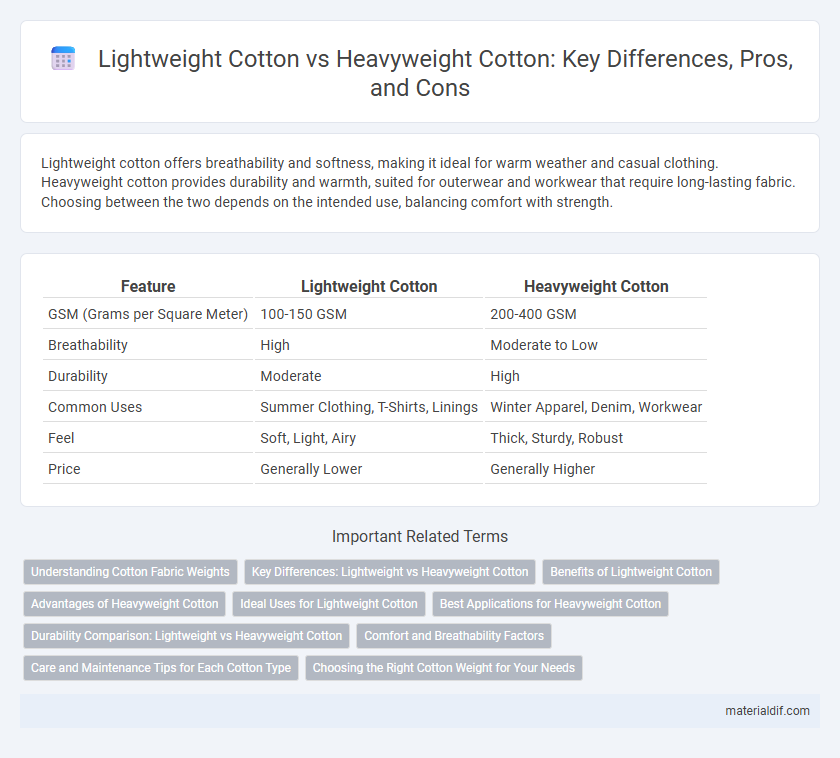Lightweight cotton offers breathability and softness, making it ideal for warm weather and casual clothing. Heavyweight cotton provides durability and warmth, suited for outerwear and workwear that require long-lasting fabric. Choosing between the two depends on the intended use, balancing comfort with strength.
Table of Comparison
| Feature | Lightweight Cotton | Heavyweight Cotton |
|---|---|---|
| GSM (Grams per Square Meter) | 100-150 GSM | 200-400 GSM |
| Breathability | High | Moderate to Low |
| Durability | Moderate | High |
| Common Uses | Summer Clothing, T-Shirts, Linings | Winter Apparel, Denim, Workwear |
| Feel | Soft, Light, Airy | Thick, Sturdy, Robust |
| Price | Generally Lower | Generally Higher |
Understanding Cotton Fabric Weights
Lightweight cotton typically ranges from 2 to 4 ounces per square yard, offering breathability and comfort ideal for summer clothing and delicate garments. Heavyweight cotton, often exceeding 8 ounces per square yard, provides durability and insulation suitable for outerwear, denim, and workwear. Understanding cotton fabric weights helps in selecting the right material based on garment function, climate, and comfort preferences.
Key Differences: Lightweight vs Heavyweight Cotton
Lightweight cotton features a finer weave and lower thread count, making it breathable and ideal for warm climates or layering. Heavyweight cotton has a denser weave and higher thread count, providing greater durability and insulation suited for outerwear and cold weather. Key differences include weight per square yard, durability, and thermal retention properties, which impact comfort and functionality in various applications.
Benefits of Lightweight Cotton
Lightweight cotton offers superior breathability and moisture-wicking properties, making it ideal for warm climates and active wear. Its soft texture ensures enhanced comfort and reduced irritation, especially in sensitive skin. This type of cotton also dries faster than heavyweight cotton, contributing to better overall garment durability and ease of care.
Advantages of Heavyweight Cotton
Heavyweight cotton offers superior durability and enhanced insulation compared to lightweight cotton, making it ideal for long-lasting garments and cold-weather apparel. Its dense fiber structure provides excellent resistance to wear and tear while maintaining breathability and comfort. This makes heavyweight cotton a preferred choice for workwear, outerwear, and products requiring robust fabric strength and thermal retention.
Ideal Uses for Lightweight Cotton
Lightweight cotton, characterized by its breathable and soft texture, is ideal for summer clothing, casual shirts, and baby garments due to its moisture-wicking properties and comfort in warm climates. This fabric supports enhanced airflow, reducing heat retention and making it perfect for activewear and layering pieces that require flexibility and lightness. Its delicate weave also suits fine linens and dress shirts, where softness and drape are prioritized over durability.
Best Applications for Heavyweight Cotton
Heavyweight cotton is ideal for applications requiring durability and warmth, such as workwear, denim jeans, and upholstery. Its dense fibers provide excellent abrasion resistance and insulation, making it suitable for outdoor gear and heavy-duty garments. This cotton type also performs well in industrial textiles where strength and longevity are critical.
Durability Comparison: Lightweight vs Heavyweight Cotton
Heavyweight cotton offers superior durability compared to lightweight cotton due to its denser fiber structure and higher thread count, making it ideal for items subjected to frequent wear and abrasion. Lightweight cotton, while softer and more breathable, tends to wear out faster under heavy use because its thinner threads are less resistant to tearing and pilling. The durability of heavyweight cotton makes it a preferred choice for workwear, upholstery, and durable garments where longevity is crucial.
Comfort and Breathability Factors
Lightweight cotton offers superior breathability and comfort, making it ideal for warm weather due to its thinner fibers and increased airflow. Heavyweight cotton provides durability and warmth, but its denser weave can reduce breathability and result in less comfort during hot conditions. Choosing between lightweight and heavyweight cotton depends on the desired balance of comfort, temperature regulation, and fabric resilience.
Care and Maintenance Tips for Each Cotton Type
Lightweight cotton requires gentle washing in cold water and air drying to prevent shrinking and maintain fabric softness, while heavyweight cotton benefits from warm water washes and tumble drying on low heat to preserve durability and structure. Both types should avoid bleach and use mild detergents to protect fibers and colors. Storing cotton in a cool, dry place away from direct sunlight helps minimize fading and fabric degradation over time.
Choosing the Right Cotton Weight for Your Needs
Lightweight cotton, typically ranging from 3 to 4 ounces per square yard, offers breathability and flexibility, making it ideal for summer apparel and layering pieces. Heavyweight cotton, often 6 ounces or more, provides durability and warmth suited for outerwear, workwear, and upholstery. Selecting the right cotton weight depends on the intended use, climate, and comfort preferences, ensuring optimal performance and garment longevity.
Lightweight Cotton vs Heavyweight Cotton Infographic

 materialdif.com
materialdif.com